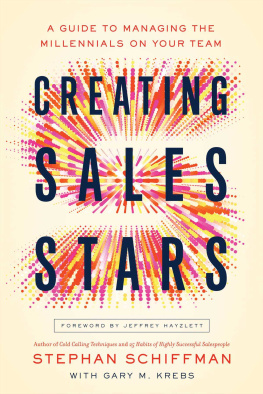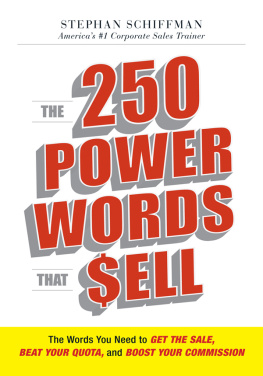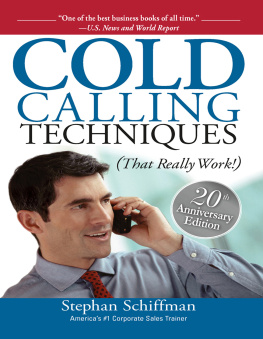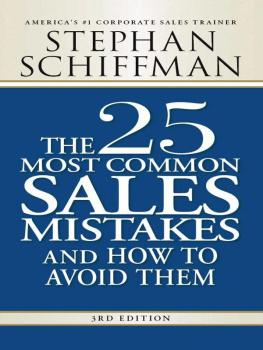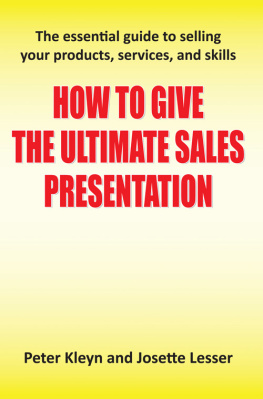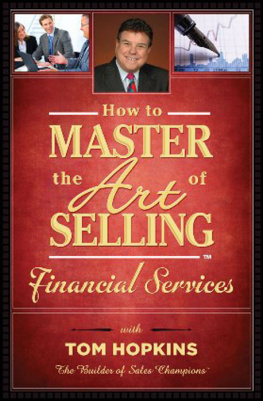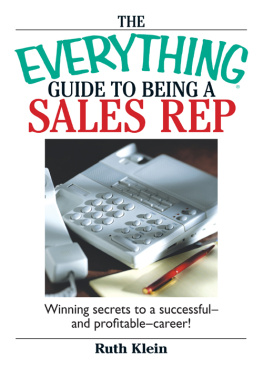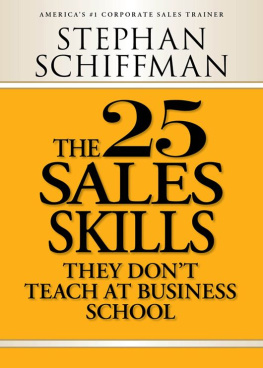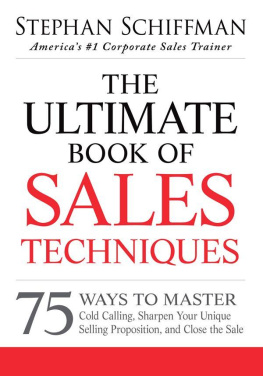

Copyright 2013 by Stephan Schiffman. All rights reserved. Except as permitted under the United States Copyright Act of 1976, no part of this publication may be reproduced or distributed in any form or by any means, or stored in a database or retrieval system, without the prior written permission of the publisher.
ISBN: 978-0-07-179163-2
MHID: 0-07-179163-9
The material in this eBook also appears in the print version of this title: ISBN: 978-0-07-179162-5, MHID: 0-07-179162-0.
All trademarks are trademarks of their respective owners. Rather than put a trademark symbol after every occurrence of a trademarked name, we use names in an editorial fashion only, and to the benefit of the trademark owner, with no intention of infringement of the trademark. Where such designations appear in this book, they have been printed with initial caps.
McGraw-Hill eBooks are available at special quantity discounts to use as premiums and sales promotions, or for use in corporate training programs. To contact a representative please e-mail us at bulksales@mcgraw-hill.com.
TERMS OF USE
This is a copyrighted work and The McGraw-Hill Companies, Inc. (McGraw-Hill) and its licensors reserve all rights in and to the work. Use of this work is subject to these terms. Except as permitted under the Copyright Act of 1976 and the right to store and retrieve one copy of the work, you may not decompile, disassemble, reverse engineer, reproduce, modify, create derivative works based upon, transmit, distribute, disseminate, sell, publish or sublicense the work or any part of it without McGraw-Hills prior consent. You may use the work for your own noncommercial and personal use; any other use of the work is strictly prohibited. Your right to use the work may be terminated if you fail to comply with these terms.
THE WORK IS PROVIDED AS IS. McGRAW-HILL AND ITS LICENSORS MAKE NO GUARANTEES OR WARRANTIES AS TO THE ACCURACY, ADEQUACY OR COMPLETENESS OF OR RESULTS TO BE OBTAINED FROM USING THE WORK, INCLUDING ANY INFORMATION THAT CAN BE ACCESSED THROUGH THE WORK VIA HYPERLINK OR OTHERWISE, AND EXPRESSLY DISCLAIM ANY WARRANTY, EXPRESS OR IMPLIED, INCLUDING BUT NOT LIMITED TO IMPLIED WARRANTIES OF MERCHANTABILITY OR FITNESS FOR A PARTICULAR PURPOSE. McGraw-Hill and its licensors do not warrant or guarantee that the functions contained in the work will meet your requirements or that its operation will be uninterrupted or error free. Neither McGraw-Hill nor its licensors shall be liable to you or anyone else for any inaccuracy, error or omission, regardless of cause, in the work or for any damages resulting therefrom. McGraw-Hill has no responsibility for the content of any information accessed through the work. Under no circumstances shall McGraw-Hill and/or its licensors be liable for any indirect, incidental, special, punitive, consequential or similar damages that result from the use of or inability to use the work, even if any of them has been advised of the possibility of such damages. This limitation of liability shall apply to any claim or cause whatsoever whether such claim or cause arises in contract, tort or otherwise.
To Julia Anne Heffernan,
and to her brother, mother, and father
CONTENTS
ACKNOWLEDGMENTS
My sincere thanks for the success of this project go to Monika Verma, Gary Krebs, Donya Dickerson, Tom Jared, Darren Newton, Anthony Bartolo, Tobias W. Heffernan, Joshua Michael Sanders, and, of course, Anne, Daniele, and Jennifer.
Equally significant are all those salespeople who go out each day to prospect, meet new people, and make sales. These are my true inspiration. Thank you, all.
INTRODUCTION
It was an odd situation.
In fact, I couldnt remember when Id last run into the problem. During four decades of selling, Ive encountered almost every conceivable reaction, from clients who acted as if Id brought them Aladdins magic lamp to others who clearly couldnt wait to show me the door. Emotionally, theyd run the gamut from eager enthusiasm to the sort of gloom-and-doom pessimism that would make Eeyore seem in comparison like a cheerleader for the Dallas Cowboys.
But in all those years, the clients had understood what I was selling. I didnt think it was particularly complicated. Yet here was this pleasant young man, dressed in a neat suit and tie and sitting behind an orderly desk, staring at me as if Id asked him to explain Einsteins Theory of the Unified Field. His brows were drawn together, and he tapped a pencil nervously on the pad in front of him. I noticed, with trepidation, that hed yet to take a single note. Not a good sign.
He shook his head. Im sorry, Steve, but I still dont get it. Just what is it that your company is offering to do for us?
I suppressed a sigh, straightened my tie, and tried to keep my voice light and genial. Were sales trainers. We train people how to sell. And I can come into your company, make a presentation to your sales force, and work with your salespeople. In the end, youll find that as a result of my training, youll see a substantial uptick in your sales.
He still looked puzzled. So youre selling me a package of CDs with sales presentations?
Uh, no. I tried again. Id actually come to your company in person and do presentations.
But why wouldnt I want my own sales director to do that? he asked. It wasnt a smart-ass question or a way of pushing back against my presentation. He genuinely wanted to know.
Well, I countered, he could, of course. But what Im offering is a long record of experience in selling and half a million salespeople trained.
He shook his head. That sounds very impressive, Steve, but I dont know how to measure that. I dont know how to put a specific dollar value on what youre offering, and that makes me very nervous. He smiled faintly. And I never like being nervous.
Much later, when the call had come to an uneasy conclusion (we agreed to meet in two weeks after hed had time to study the materials I left with him and discuss the matter with his sales director and CFO), and I was heading back to the office, I turned the matter over and over in my mind. Some salespeople can push a bad or mediocre sales call out of their minds immediately, but Im not one of them. I kept wondering if there was something I could have said or done that might have made things go in a different direction. Was there a fundamental problem with my presentation? I was pretty sure there wasnt, because this was the same basic presentation Id been making, with a considerable degree of success, for a lot of years, and I didnt think the world had suddenly changed in the past 24 hours.
So what was the difficulty?
It finally came to meand its probably come to you already. What he didnt get was that I wasnt selling a thing, an object, a physical product. Instead, I was selling a service, something that by its nature is intangible. And for many people, this is something thats harder to grasp.
As it happens, I had an opportunity to test my theory a week or two later. I was attending a wedding out of town, one at which I didnt know most of the people. After watching the bride go down the aisle and applauding when the minister presented the newly married couple to the assembled guests, we broke for a short cocktail hour before the dinner. I had an opportunity to chat with some of my fellow guests and get to know them a bit. However, I carefully refrained from saying what I did for a living. Bearing in mind my experience of some weeks earlier, I saw this as a chance to find out more about the distinction people make between selling a service and selling a product.
Next page

